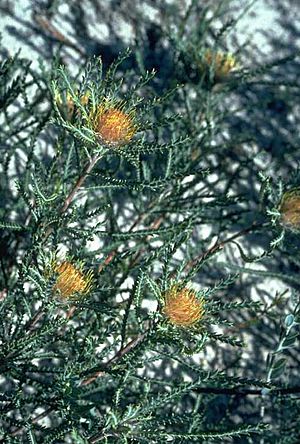Banksia sclerophylla facts for kids
Quick facts for kids Banksia sclerophylla |
|
|---|---|
 |
|
| Scientific classification | |
| Genus: |
Banksia
|
| Species: |
sclerophylla
|
| Synonyms | |
|
|
Banksia sclerophylla is a special type of shrub found only in the southwest part of Western Australia. It has stems that spread out, and its leaves are long and narrow with triangle-shaped edges. This plant grows pretty yellow flowers, usually in groups of 40 to 70. After flowering, it produces oval-shaped seed pods called follicles.
What it Looks Like
Banksia sclerophylla is a shrub with stems that spread out and are a bit hairy. It usually grows to about 60 centimeters (about 2 feet) tall. This plant has a special underground woody swelling called a lignotuber, which helps it regrow after a fire.
Its leaves are long and thin, measuring about 6 to 13 centimeters (2.4 to 5.1 inches) long. They are 4 to 6 millimeters (0.16 to 0.24 inches) wide. Each leaf has a short stalk, or petiole, about 2 to 5 millimeters long. The sides of the leaves have between 10 and 30 small, triangular points.
The flowers are bright yellow and grow in a cluster at the end of the stems. Each cluster holds between 40 and 70 flowers. At the base of the flower cluster, there are pale, spear-shaped leaves called involucral bracts. These bracts are covered with rust-colored hairs and can be up to 15 millimeters long.
Each individual flower has a part called a perianth, which is about 19 to 22 millimeters long. The pistil, which is the female part of the flower, is about 25 to 27 millimeters long and gently curved. Banksia sclerophylla usually flowers from September to October. After the flowers, it forms oval-shaped seed pods, or follicles, that are about 7 to 9 millimeters long and 8 to 10 millimeters wide.
How it Got its Name
This plant was first officially described in 1855 by a scientist named Carl Meissner. He gave it the name Dryandra sclerophylla. His description was published in a science journal called Hooker's Journal of Botany and Kew Garden Miscellany. The plant specimens he studied were collected by James Drummond.
The second part of its name, sclerophylla, comes from two ancient Greek words. "Sclero" means "hard," and "phylla" means "leaved." So, sclerophylla means "hard-leaved," which describes its tough leaves.
Later, in 2007, two other scientists, Austin Mast and Kevin Thiele, moved all plants from the Dryandra group into the Banksia group. That's when this plant officially became known as Banksia sclerophylla.
Where it Lives
Banksia sclerophylla grows in a type of shrubland called kwongan in Western Australia. You can find it in areas between the Alexander Morrison National Park, Mount Lesueur, and Badgingarra.
Conservation Status
The Western Australian Government's Department of Parks and Wildlife has classified this banksia as "not threatened." This means it is not currently at risk of disappearing.

